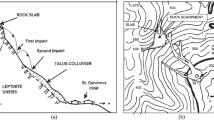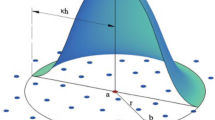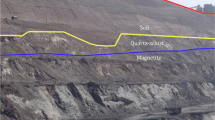Abstract
The problem of slope stability is an important research topic in geotechnical engineering. Taking a gravel slope as the background, the large deformation and failure region of slope was regarded as a discrete zone, modeled by PFC3D, and small deformation region was regarded as a continuous zone, modeled by FLAC3D. The Mohr–Coulomb criterion and tensile stress yield criterion were adopted in the continuous zone and the linear contact stiffness model was used to depict the contact relationship of particles in the discrete zone. The discrete–continuous coupled model of slope was established by transferring velocity and force between the discrete zone and the continuous zone and the micro instability mechanism of the gravel slope was studied by gravity increase method. The progressive damage process of slope instability and the evolution of porosity and coordination number were studied by arranging measurement spheres and observing the movement pattern of particles. Based on the particle displacement, kinetic energy of slope and convergence of numerical simulation, the stability criterion of slope after instability was discussed. It is found that the safety factor of the gravel slope was 1.1. The insight into the evolution process of slope instability can provide reference for slope treatment.





























Similar content being viewed by others
References
Krahn J (2003) The 2001 R.M. Hardy Lecture: the limits of limit equilibrium analyses. Can Geotech J 40:643–660
Donald IB, Chen Z (2011) Slope stability analysis by the upper bound approach: fundamentals and methods. Can Geotech J 34(6):853–862
Zhang LY, Zheng YR, Zhao SY, Shi WM (2003) Research on the accuracy of finite element strength reduction factor method to calculate the safety factor of soil slope stability. J Hydraul Eng 34(1):21–27
Cheng CH, Lei J, Huang JH, Cheng XH, Zhang ZC (2018) Finite element limit analysis of slope stability reliability considering spatial variability of soil strength. Chin J Geotech Eng 40(6):985–993
Zhang JW, Li XJ, Wang XM, Chi MJ, Wang YS (2018) Method for judging seismic stability state of soil slopes. Chin J Geotech Eng 40(11):2096–2102
Yu HJ, Peng SQ, Zhao QH (2018) Research on response of laterally loaded pile in gravel soil sloping ground. Rock Soil Mech 39(7):2537–2546
Duan X, Zhang J, Huang H, Zeng P, Zhang L (2021) System reliability analysis of soil slopes through constrained optimization. Landslides 18:655–666
Scholtès L, Donzé FV (2012) Modelling progressive failure in fractured rock masses using a 3D discrete element method. Int J Rock Mech Min Sci 52:18–30
Huang D, Cen D, Ma G, Huang R (2015) Step–path failure of rock slopes with intermittent joints. Landslides 12:911–926
Lin CH, Lin ML (2015) Evolution of the large landslide induced by Typhoon Morakot: a case study in the Butangbunasi River, southern Taiwan using the discrete element method. Eng Geol 197:172–187
Wei J, Zhao Z, Xu C, Wen Q (2019) Numerical investigation of landslide kinetics for the recent Mabian landslide (Sichuan, China). Landslides 16(4):2287–2298
Cundall PA (1971) A computer model for simulating progressive, large scale movements in blocky rock systems. In: Proceedings of the International Symposium on Rock fracture, Nancy.
Cundall PA, Strack ODL (1979) A discrete numerical model for granular assemblies. Géotechnique 29(1):47–65
Zhou J, Wang JQ, Zeng Y, Zhang J (2009) Simulation for soil slope stability analysis by particle flow code. Rock Soil Mech 30(1):86–90
Liu Z, Koyi HA (2013) Kinematics and internal deformation of granular slopes: insights from discrete element modeling. Landslides 10:139–160
Lu CY, Tang CL, Chan YC, Hu JC, Chi CC (2014) Forecasting landslide hazard by the 3D discrete element method: a case study of the unstable slope in the Lushan hot spring district, central Taiwan. Eng Geol 183:14–30
Peng J, Wong LNY, Teh CI (2017) Effects of grain size–to–particle size ratio on micro–cracking behavior using a bonded–particle grain–based model. Int J Rock Mech Min Sci 100:207–217
Felippa CA, Park KC (1980) Staggered transient analysis procedures for coupled mechanical systems: formulation. Comput Methods Appl Mech Eng 24(1):61–111
Cai M, Kaiser PK, Morioka H, Minami M, Maejima T, Tasaka Y, Kurose H (2007) FLAC/PFC coupled numerical simulation of AE in large–scale underground excavations. Int J Rock Mech Min Sci 44:550–564
Vyazmensky A, Stead D, Elmo D, Moss A (2010) Numerical analysis of block caving–induced instability in large open pit slopes: a finite element/discrete element approach. Rock Mech Rock Eng 43(1):21–39
Zhang H, Lu Y (2010) Continuum and discrete element coupling approach to analyzing seismic responses of a slope covered by deposits. J Mt Sci 7:264–275
Feng ZY, Lo CM, Lin QF (2017) The characteristics of the seismic signals induced by landslides using a coupling of discrete element and finite difference methods. Landslides 14(2):661–674
Xu WJ, Zhao Y (2018) A coupling finite–discrete element method for mechanical analysis of granular materials. In: Proceedings of GeoShanghai 2018 international conference: fundamentals of soil behaviours. Springer, Singapore, pp 901–910
Li Y, Yang Z, Lu Y, Hu Z, Wang C, Zhang W (2020) A three–dimensional dual–scale coupled approach and its application in geotechnics. Eng Comput Mech 173(2):83–97
China Association of Geological Hazard Prevention (2018) Design specification of anti-sliding piles of improvement engineering. China University of Geosciences Press, Wuhan
Luo Y (2007) Simulation of soil mechanical behaviors using discrete element method based on particle flow code and its application. Ph.D. Thesis, Zhejiang University, Hangzhou, China
Swan CC, Seo YK (1999) Limit state analysis of earthen slopes using dual continuum/FEM approaches. Int J Numer Anal Methods 23:1359–1371
Zhou J, Wang JQ, Zeng Y, Jia MC (2009) Slope safety factor by method of particle flow code strength reduction and gravity increase. Rock Soil Mech 30(6):1549–1554
Itasca Consulting Group (2005) Particle flow code in 3 dimensions, 3rd edn. ITASCA Consulting Group Inc., Minneapolis
Song K, Wu S, Zhang S (2018) Progressive failure analysis of accumulation slope based on discrete element strength reduction method. In: Proceedings of GeoShanghai 2018 international conference: fundamentals of soil behaviours. Springer, Singapore, pp 873–881
Cheng YM, Lansivaara T, Wei WB (2007) Two–dimensional slope stability analysis by limit equilibrium and strength reduction methods. Comput Geotech 34:137–150
Tan RJ, Li MS, Xu PX, Hu RL, Su Y (2009) Numerical simulation of dynamic stability of slope rock mass under seismic loading. Chin J Rock Mech Eng 28(2):3986–3992
Tu Y, Liu X, Zhong Z, Li Y (2016) New criteria for defining slope failure using the strength reduction method. Eng Geol 212:63–71
Huang L, Huang S, Lai Z (2020) On an energy-based criterion for defining slope failure considering spatially varying soil properties. Eng Geol 264:1–11
Dawson EM, Roth WH, Drescher A (1999) Slope stability analysis by strength reduction. Geotechnique 49(6):835–840
Cho SH (2007) Effects of spatial variability of soil properties on slope stability. Eng Geol 92:97–109
Author information
Authors and Affiliations
Corresponding author
Ethics declarations
Conflict of interest
On behalf of all authors, the corresponding author states that there is no conflict of interest.
Additional information
Publisher's Note
Springer Nature remains neutral with regard to jurisdictional claims in published maps and institutional affiliations.
Rights and permissions
Springer Nature or its licensor (e.g. a society or other partner) holds exclusive rights to this article under a publishing agreement with the author(s) or other rightsholder(s); author self-archiving of the accepted manuscript version of this article is solely governed by the terms of such publishing agreement and applicable law.
About this article
Cite this article
Li, Y., Zhao, S. & Yang, Z. Micro instability mechanism of gravel slope based on discrete–continuous method. Comp. Part. Mech. 10, 837–851 (2023). https://doi.org/10.1007/s40571-022-00535-0
Received:
Revised:
Accepted:
Published:
Issue Date:
DOI: https://doi.org/10.1007/s40571-022-00535-0




